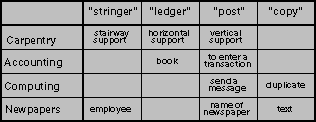
Comparison of FERRET's retrieval performance on a collection of 1065 astronomy texts using 22 sample user queries with a standard boolean keyword query system showed that PRECISION increased from 35 to 48 percent, and RECALL more than doubled, from 19.4 to 52.4 percent.
This paper describes the FERRET system's architecture, parsing and matching abilities, and focuses on the use of the the Webster's Seventh dictionary to increase the system's lexical coverage.
We do take issue with P5: the inability of machines to recognize meaning. The FERRET project at Carnegie Mellon is an attempt to bring the power of natural language processing to bear on the information retrieval problem. We believe that current parsers are capable of recognizing meaning, and that future advances in NLP will allow machines to duplicate human judgments about text relevance.
There are two standard measures of performance in information retrieval: RECALL and PRECISION. Recall is the proportion of relevant documents that are actually retrieved, and precision is the proportion of retrieved documents that are actually relevant. These two measures may be traded off one for the other, and the goal of information retrieval is to maximize them both.
Blair and Maron documented the poor performance of word-based retrieval in their study of the STAIRS retrieval system [1]. They concluded that it resulted from the false design assumption that ``it is a simple matter for users to forsee the exact words and phrases that will be used in those documents they will find useful, and only in those documents.'' Two linguistic phenomena limit users' ability to choose effective search terms:
Polysemy, words having multiple meanings, reduces precision, because the words used to match the relevant documents may have other meanings that will be present in other irrelevant documents. For examples, a query about NASA launching a probe may retrieve texts about Congress launching a probe of NASA.
Synonymy, having multiple words or phrases to describe the same concept, reduces recall. If the author chooses one word or phrase to represent a concept, such as ``liftoff,'' and the searcher looks for the word ``launch,'' a simple word-based search will not retrieve the document.

Figure 1: Synonymy and Polysemy
Figure 1 shows just how promiscuous words can be. It shows four words and four domains that together have ten different meanings. A partial solution to the problem of polysemy is to index texts by word senses instead of words themselves [10, 14]. A partial solution to the problem of synonymy is to use a thesaurus to generate search terms that are synonyms of those given by the user [17].
We have built a more complete solution to the problems of polysemy and synonymy: the FERRET conceptual retrieval system. FERRET stands for ``Flexible Expert Retrieval of Relevant English Text.'' Conceptual information retrieval is based on the ``Relevance Homomorphism'' assumption, depicted in Figure 2.
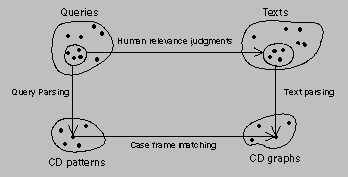
Figure 2: Relevance Homomorphism Assumption
This assumption states that the operations of query parsing, case frame matching, and text parsing form a homomorphism with human relevance judgements, and that parsing captures the ``meaning'' of the query and text as mentioned in Swanson's 5th postulate.
The START system [9] parses the text and query into T-expressions, and matches them to answer questions about the text. But these expressions are not canonical, so if the query and the text use different words or phrases, the match will fail.
The SCISOR [8] and ADRENAL systems [3, 11] are both similar to FERRET in that they use case frames as their knowledge representation. Both systems use the TRUMP parser. The major difference between SCISOR and FERRET is that SCISOR is aimed more at question answering and at text extraction than information retrieval, and therefore it is difficult to compare SCISOR with traditional information retrieval systems. Recent work on ADRENAL has focused on ``weak'' NLP techniques, including syntactic phrases, phrase clustering, word sense disambiguation and sense-disambiguated thesauri.
Note that in Figure 2 the mappings from query to CD pattern and text to CD are many-to-one. This is a consequence of choosing a canonical knowledge representation. This uniqueness property greatly simplifies the matching process, or perhaps a more fair statement is that it improves the accuracy of matching for a given level of simplicity. This improved matching provides increased recall performance.
FERRET is composed of three major modules: the text parser (a derivative of FRUMP [5, 6] called MCFRUMP), the case frame matcher, and the query parser (simulated for this study by MCFRUMP itself). For a detailed description of FERRET, see [12].
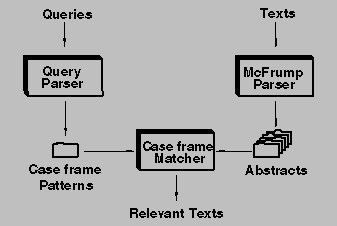
Figure 3: Simple Diagram of FERRET
The FRUMP parser forms the core of FERRET's text understanding ability; it was chosen over other kinds of parsers for several reasons. FRUMP demonstrated an impressive ability to read a broad class of real world texts. FRUMP's parsing ``philosophy'' of skimming to find the gist of a text seemed more appropriate for use in text retrieval than slower but more complete parsers. This style of parsing is also more robust, since the parser can tolerate skipping over complex material. And since it used case frames (in the form of conceptual dependency graphs and instantiated sketchy scripts) as its output, it fitted well to our model of text processing.
FRUMP stored its scripts in a discrimination tree (called an SSIDT). By clever use of this data structure, FRUMP was able to do script-based processing of inputs in time logarithmically related to the number of scripts in its database, and as a result it was very fast. FRUMP would ``skim'' its input texts to determine their main themes without slogging through each and every word.
Frump successfully analyzed 10% of the news stories on the UPI wire, requiring an average of 20 seconds per story. DeJong claimed that Frump is theoretically capable of understanding 50% of the UPI wire. ``Successful'' here means that it correctly understood the main theme of the text M some stories were not understood because although Frump correctly found the subthemes, it did not correctly identify the main point. Others failed because FRUMP misinterpreted the actions in the story, or simply lacked the necessary information to process the story.
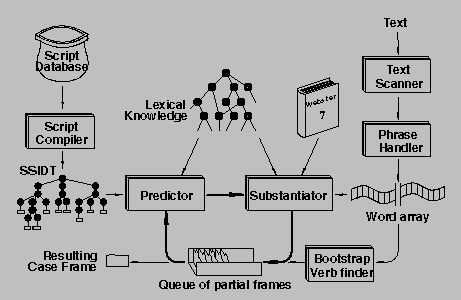
Figure 4: The MCFRUMP Parser
For the FERRET project, we re-implemented a simpler version of FRUMP in Franz Lisp (the original FRUMP was coded in M-expression Lisp, and compiled into UCI Lisp). The major difference is that MCFRUMP uses a simpler style of sketchy script. The original FRUMP script database was converted into the simpler form automatically, and scripts for newer domains (such as Astronomy and Dow Jones) were coded in the new script formalism. Figure 4 shows the internal structure of MCFRUMP, which is almost identical to that of FRUMP.
The text scanner is implemented as a pair of Lex programs that convert date, time and numeric expressions into tokens, to simplify later parsing. The boot-strap verb finder searches the word array left-to-right until a structure building word is found. That partial structure is added as the first entry to the queue of partial structures. This list is used by the predictor to perform a breadth first search of the possible concepts representing the input text. The predictor pops the top structure off of the queue and tries to extend it using the substantiator. If the substantiator can extend the structure, the new structure (or structures) is added to the end of the queue.
The substantiator uses the lexical knowledge base to determine whether a given word in the word array can have a particular meaning. For example, if the predictor is looking for a person, and the substantiator finds ``Virginia,'' there is a match, and the substantiator builds a slot-filler containing a feminine first name, indicating a particular person. If the predictor had been looking for a location, the substantiator would have instead built a structure for the state of Virginia. The lexical knowledge is stored as a collection of FRAMEKIT frames [13]. If the word is not in the lexicon, the dictionary interface tries to find it in Webster's. If the word is found, the dictionary interface builds a FRAMEKIT frame and adds it to the lexical knowledge (for the current Lisp session only).
We chose the Astronomy domain for the initial FERRET study, mainly because of the availability of texts from the UseNet newsgroup SCI.ASTRO (originally known as NET.ASTRO). Figure 5 shows two sample texts from this collection. These are scripts for the StarDate radio program heard daily on National Public Radio. We initially obtained 279 texts from the network news feed, and subsequently obtained another 1065 astronomy texts directly from the University of Texas McDonald Observatory. The average length of one text is 300 words or about 1800 characters.
The StarDate texts have one very desirable feature for natural language processing: they are narrative. Since they are meant to be read aloud, the information is conveyed sequentially without reference to charts, graphs, figures or references to other articles in the newsgroup. This matches most closely with the way FERRET reads text: one word at a time.
For the knowledge base, we started with the script database and lexicon from DeJong's FRUMP. Since this database was oriented towards the UPI newswire, there was very little conceptual overlap with the content of the SCI.ASTRO newsgroup. To handle astronomy, a domain description consisting of a script database and lexicon was written with 5 basic scripts (using 10 requests in all). This database took one graduate student about 40 hours to write. The basic scripts are:
Article 1307 of 1351, Mar 3 02:00. Subject: Pioneer 10 From: dipper@@utastro Organization: U. Texas, Astronomy, Austin, TX Newsgroups: net.astro Date: Mon, 3-Mar-86 02:00:18 EST Pioneer 10 was the first spacecraft to venture into the outer solar system. More -- coming up. March 3 Pioneer 10 On today's date in the year 1972, NASA's Pioneer 10 spacecraft was launched toward the outer solar system. It was to become the first craft to travel beyond the asteroid belt -- and the first to encounter mighty Jupiter... Script by Deborah Byrd.
Article 192 of 4 Aug 85. Subject: Jupiter at Opposition From: dipper@@utastro Organization: U. Texas, Astronomy, Austin, TX Newsgroups: net.astro Date: 4-Aug-85 02:00:00 EST The planet Jupiter today falls behind Earth in the race around the sun. More -- after this. August 4 Jupiter at Opposition... You can probably spot Jupiter now, and for the next few months, as the very bright object in the east each evening. Jupiter shines brilliantly by virtue of its large size, its bright cloud cover which reflects sunlight so well, and its relative nearness to Earth right now... Script by Deborah Byrd.
Figure 5: Excerpts from Two StarDate Texts
To support these five scripts, the lexicon from Frump was extended with additional frames for objects and actions that occur commonly in astronomy texts. There are:
Common extensions included words for seeing things (image, photograph, glimpse), for certain kinds of motion (orbit, launch, rise), plus a great many proper names (of stars, comets, planets, nebulae, and constellations). The content of the lexicon was adjusted by running the parser several times on the initial set of 279 StarDate radio texts. The scripts database was fixed, however, before the larger dataset was obtained from McDonald Observatory.
FERRET uses four levels of lexical knowledge:
Pioneer 10 was the first spacecraft to venture
into the outer solar system.
FERRET first tries to find a structure building word (usually a verb). Scanning left to right, it finds ``venture,'' which is not in the lexicon. None of the synonyms for venture are in FERRET's lexicon, so it checks the definitions for near-synonyms, and finds two: ``to offer'' (*MTRANS) and ``to proceed'' (*PTRANS). FERRET uses the script constraints to invalidate the interpretation that the outer solar system is receiving an offer, and correctly chooses the physical motion sense of ``proceed.''
Figure 7 shows a portion of the Webster's entry for ``spot,'' and Figure 8 shows how the dictionary synonym entry NOTICE, which has a link to word sense SEE1 (*PERCEIVE), is used to parse the sentence
``You can probably spot Jupiter now.''
The dictionary can be a dangerous place to look for information about words. The Webster's entry for ``spot'' includes 39 different word senses, and the synonyms given are themselves ambiguous. For example, one of the definitions of ``spot'' is ``to lie at intervals,'' which could easily be mistaken by FERRET to attribute a meaning of ``bearing false witness'' to the word ``spot.'' FERRET is able to use this highly ambiguous information only because of the strong semantic constraints imposed by its script database. This extra lexical coverage comes at the price of CPU time spent considering and rejecting many irrelevant senses of the words found in the dictionary.
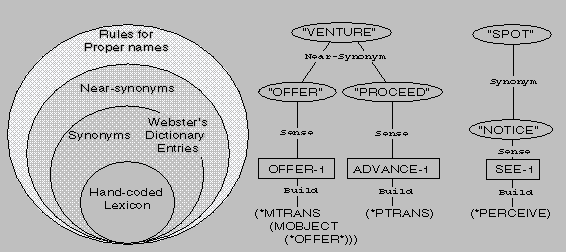
Figure 6: Levels of Lexical Knowledge
% lookup spot | dtl
(w7-spot-1 2 synonyms and 17 definitions omitted)
(w7-spot-2
(pos verb)
(variant
(spotted ppart)
(spotting ger))
(synonym
(disgrace) (stain) (identify)
(detect notice) (stud))
(definition
(to stain the character or
reputation of %colon %colon
disgrace)
(to mark in or with a spot
%colon %colon stain)
(to lie at intervals in or
over %colon %colon stud)
12 other definitions omitted)
(related (spottable adjective)))
(w7-spot-3 7 definitions omitted)
Figure 7: Automatically formatted entries from Webster's
Sentence:
(p-2978 %cpt you can probably spot %cpt jupiter
now %comma)
Using synonym of 'spot' => see1
******* spot (see1) builds:
(cd (<=> (*perceive*)))
With modifiers (cd (<=> (*perceive*))
(mode (*probable*))
(tense (future)))
Parse Rule 2 fills 'actor' with (*you*)
Parse Rule 2 fills 'object' with (*jupiter*)
Accepting script
(astro-view-r1
(&viewer (*you*))
(&view-object (*jupiter*))
(&view-date (*now*))
(&view-mode (*probable*)))
Parsing time: 41.36 seconds
Figure 8: Using a synonym from Webster's to parse
We evaluated the retrieval performance of FERRET on the astronomy texts
described in Section 3.3. The collection of 1065 texts was sorted by creation
date, and split into a training and an evaluation set. The training set
contained the 533 odd-numbered texts. This set was used to refine and train
the parser and its script learning component. The second set of 532
even-numbered texts was used to evaluate the retrieval performance, and was
not seen by the author until after the parser and lexicon were complete.
After the parser and lexicon were tuned on the training set, 44 user queries
were obtained from 22 computer science graduate students. Neither the parser
nor the lexicon was changed after the queries were obtained. Each student was
sent a survey form with three different paragraphs automatically chosen at
random from both the training and
evaluation test sets. The students were asked to think of a natural language
query that would retrieve at least one of the paragraphs, to mark each
paragraph that should be retrieved by the query, and to provide a keyword
version of their query as well.
Since the FERRET project focused on parsing texts rather than queries, the
MCFRUMP parser was used to substitute for the unimplemented query parser
(query parsing has also been extensively studied, see for example [2]). Of
the 44 queries, 22 were not parseable at all by MCFRUMP, and 16 required
paraphrasing, while 6 were parsed as is (the complete list of parses and
paraphrases is given in [12]). This way, any experimenter bias would be
visible in the English paraphrases instead of hidden in parenthesis-laden
case-frames. These patterns obtained from the 22 parsed sentences were
matched against the parser output from the training and evaluation sets. The
results are shown in Figures 9 and 10.
Figure 9: Retrieval Performance on Training Set
Figure 10: Retrieval Performance on Evaluation Set
Figure 11: Absolute Recall Performance
The keyword versions of the queries were evaluated using a simple boolean
keyword query system that provided functions for AND, OR, NOT, stemming, and
ADJACENCY. In a few cases where the users had been overly specific, the
keyword queries were modified to improve their performance. The relative
recall performance was the proportion of the total number of documents
retrieved that were retrieved by one method or the other. These are only
upper bounds on the actual recall performance.
To estimate the absolute level of recall of both systems, a random sample of 5
of the 44 queries was chosen, and the entire evaluation set was manually
searched for texts relevant to these 5 queries, and the recall rates were
recomputed. The results of this study are shown in Figure 11. Regardless of
the actual recall performance, the FERRET system retrieved 2.53 times as many
relevant documents as the boolean keyword query. For more detailed discussion
of this experiment, and especially for more discussion of FERRET's script
learning component, see [12].
To determine how the dictionary interface affected parsing, a comparison study
was done by parsing a sample of 50 texts both with and without the dictionary
and with and without time limits. This was done separately from the retrieval
study; the retrieval study was done with time limits of 8 minutes per text, 3
minutes per sentence, and with the dictionary enabled.
The normal processing mode for MCFRUMP includes a time limit of 8 minutes per
text and 3 minutes per single sentence. Because the parser attempts to
resolve all possible meanings of a sentence, a highly ambiguous sentence, or a
sentence with many pronouns, can require hours to parse. These limits keep
MCFRUMP from getting stuck on any one sentence or article.
Early tests of the parser were done on the training set with tighter limits of
4 minutes per story and 2 minutes per sentence. As a control, the parser was
run without the dictionary interface using these same limits. The results are
shown in Table 12. To our surprise, the parser understood more sentences
without using the dictionary.
Closer investigation of parser traces showed that using the dictionary
drastically increased the amount of ambiguity resolution required by the
parser. Since more words now had plausible meanings, more work was required
to confirm or disconfirm possible interpretations of any one sentence.
With the dictionary, sentences appearing earlier in the text were more likely
to be parsed, but the parser ran out of time before it read very far into the
text. Without the dictionary, early sentences were less likely to be parsed
correctly, but there were slightly fewer misunderstood sentences, and the
parser often found simpler sentences later in the text that it could
understand.
The net result was that more sentences were understood with slightly higher
precision without the dictionary. But in some cases, these sentences appeared
much later in the text and sometimes dealt with secondary topics.
A second comparison study was performed, this time without any time limits on
the parser. This way, the effect of the dictionary on understanding could be
studied in isolation from time effects. Because of the increased time needed,
a smaller sample of 50 texts was randomly chosen from the training set and
used for this study. The results are shown in Table 13. This time, the
parser understood more sentences with the dictionary than without.
Investigation of parser traces from the second study showed that, like
the first test, early sentences were more likely to be understood by
using the dictionary, and that the abstracts produced were somewhat
more representative of the texts (approximately one fifth of the texts
had much more accurate abstracts because the early sentences were
better understood).
Figure 12: Effect of Dictionary with time limits
Figure 13: Effect of Dictionary without time limits
Before summarizing, we present two directions for future work: generalizing
the skimming parser to languages other than English, and investigating the
performance of conceptual retrieval on standard IR corpora.
We are investigating the ability of a FRUMP style parser to process text in
languages other than English. Figure 14 shows a portion of an article from
the OPS 27Reunion. The English translation is
Figure 15 shows the same sentence translated into Japanese. Figures 16 and 17
show the actual instantiated sketchy scripts produced by the parser (the parse
shown in Figure 17 was produced from the segmented Romaji text). Both texts
were parsed using the same script database, and
the resulting frames differ only in the order of the slots in the *CASE frame
(the order is different because in the Spanish text the quantifier ``167.373''
occurs before the word ``casos,'' and in the Japanese example the quantifier
comes after the word ``keesu'').
Spanish:
Figure 14: Sample Spanish Text
Kanji:
Romaji:
Figure 16: Instantiated script from Spanish parse
Since order of slots is unimportant in case frames, the two output frames are
identical. One can see that an information retrieval system based on this
kind of matching can allow a user to retrieve documents written in one
language using queries written in a different language. The changes in the
Lisp source for MCFRUMP to parse these examples were less than 5% of the total
lines of code in the system.
The FERRET project is only a single example of a conceptual retrieval system
outperforming a standard information retrieval technique (boolean keyword
query). Furthermore, boolean systems are not the best keyword-based retrieval
systems: a boolean system was used here mainly because of its convenience as a
test standard. The next obvious step is to evaluate FERRET's performance on
one or more standard IR corpora. Such a study was beyond the scope of the
initial FERRET effort, but is necessary to allow comparison of conceptual
retrieval with more sophisticated IR techniques such as relevance feedback
[15] or latent semantic indexing [4, 7].
Conceptual information retrieval using an effective, canonical knowledge
representation and case frame matching is an alternative to word-based
retrieval methods, and was shown in this study to increase both recall and
precision over standard boolean keyword query.
This study shows the ability of text skimming parsers to extract semantic
content from a medium-sized corpus of unedited English text (1065 texts is
large by AI standards, and minuscule by IR standards). FERRET also
demonstrates the use of machine-readable dictionaries and machine learning to
improve the parser's performance.
The StarDate radio texts used in this study are Copyrighted 1985 and 1986 by
the McDonald Observatory, University of Texas at Austin, and were used with
permission. The Japanese parsing example resulted from joint work with Dr.
Teruko Mitamura of the Carnegie Mellon Center for Machine Translation.
This work was supported in part by the Office of Naval Research (ONR) under
contract number N00014-84-K-0345, in part by the Defense Advanced Research
Projects Agency (DOD), ARPA Order No. 4976, monitored by the Air Force
Avionics Laboratory under contract F33615-87-C-1499, and in part by a grant
from Dow Jones and Company.
The views and conclusions contained in this document are those of the author
and should not be interpreted as representing the official policies, either
expressed or implied, of the ONR, DARPA, DOD, Dow Jones and Company, or the
U.S. Government.
5. RETRIEVAL PERFORMANCE
-------------------------------------------------------
| |
| Training set, 22 queries |
| |
|--------------------------------------------------- |
| | | | |
| | Keywords | FERRET | Learning |
| | | | |
|--------------------------------------------------- |
| | | | |
| Precision | 34.9% | 44.8% | 43.3% |
| | | | |
|--------------------------------------------------- |
| | | | |
| Relative Recall | 33.0% | 43.4% | 65.6% |
| | | | |
-------------------------------------------------------
-------------------------------------------------------
| |
| Evaluation set, 22 queries |
| |
|--------------------------------------------------- |
| | | | |
| | Keywords | FERRET | Learning |
| | | | |
|--------------------------------------------------- |
| | | | |
| Precision | 35.2% | 49.4% | 47.9% |
| | | | |
|--------------------------------------------------- |
| | | | |
| Relative Recall | 31.6% | 45.3% | 79.9% |
| | | | |
-------------------------------------------------------
-------------------------------------------------------
| |
| Evaluation Set, 5 queries |
| |
|--------------------------------------------------- |
| | | | |
| | Keywords | FERRET | Learning |
| | | | |
|--------------------------------------------------- |
| | | | |
| | 1 | 2 | |
| Precision | 79.0% | 73.4% | 65.2% |
| | | | |
|--------------------------------------------------- |
| | | | |
| Absolute Recall | 19.4% | 20.0% | 52.4% |
| | | | |
-------------------------------------------------------
6. DICTIONARY PERFORMANCE
6.1. WITH TIME CONSTRAINTS
6.2. WITHOUT TIME CONSTRAINTS
---------------------------------------------------------------
| |
| Effect of Dictionary, With 4 minute time limit per text |
| |
|----------------------------------------------------------- |
| | | | |
| Number of texts: 533 | With W7 | Without W7 | Change |
| | | | |
|----------------------------------------------------------- |
| | | | |
| Total sentences | 3312 | 7492 | -55.8% |
| Misses | 2704 | 5981 | |
| | | | |
| Sentences with some | | | |
| parse | 608 | 1511 | -59.8% |
| | | | |
| Percent "understood" | 22.5% | 25.3% | -11.1% |
| Sentences with | | | |
| script | 449 | 1194 | |
| (percent of | | | |
| sentences read) | 14% | 16% | |
| | | | |
| Sentences with | | | |
| partial parse | 159 | 317 | |
| Size of inst. | | | |
| |
| scripts | 408kbytes 820kbytes -50.2% |
| CPU hours to parse | | | |
| texts | 56.6 | 43.3 | |
| | | | |
---------------------------------------------------------------
---------------------------------------------------------------
| |
| Effect of Dictionary, With no time limit |
| |
|----------------------------------------------------------- |
| | | | |
| Number of texts: 50 | With W7 | Without W7 | Change |
| | | | |
|----------------------------------------------------------- |
| | | | |
| Total sentences | 986 | 986 | |
| Misses | 704 | 784 | |
| | | | |
| Sentences with some | | | |
| parse | 282 | 203 | +38.9 |
| Percent "understood" | 28.6% | 20.6% | |
| | | | |
| Sentences with | | | |
| script | 168 | 147 | +14.3 |
| (percent of | | | |
| sentences read) | 17.0% | 14.9% | |
| | | | |
| Sentences with | | | |
| partial | 114 | 56 | +103.6 |
| | | | |
| Size of inst. | | | |
|
| scripts | 151kbytes 109kbytes| +40.0% |
| CPU hours to parse | 43.5 | 9.7 | |
| | | | |
---------------------------------------------------------------
7. SUMMARY AND FUTURE WORK
7.1. GENERALIZING TO OTHER LANGUAGES
``As of July 1, 1989, a cumulative total of 167,373 AIDS cases had
been officially reported to the the World Health Organization Global
Program on AIDS, originating in 149 countries.''
From: OPS 27Reunion
Date: Sep 5, 1989
Al 1 de julio de 1989, un total acumulativo
de 167.373 casos de SIDA se notificaron
oficialmente al Programa Global de la
Organizacion Mundial de la Salud sobre
el SIDA (PGS), procedentes de 149 pai'ses.

1985-7-1 genzai, 149 kakoku de hasseishita
tootaru eizu keesu suu, 167373, ga PGS ni
hookoku sare masita.
Figure 15: Sample Japanese text
Activated
(incidence-r1
(&agency (*pgs*))
(&disease
(*case* (quantity (167373.0))
(disease (*aids*))))
(&origin (*country* (quantity (149.0))))
(&date (*date* (month july) (day 1)
(year 1989))))
Parsing time: 32.48 seconds
Activated
(incidence-r1
(&agency (*pgs*))
(&disease
(*case* (disease (*aids*))
(quantity (167373.0))))
(&origin (*country* (quantity (149.0))))
(&date (*date* (month july) (day 1)
(year 1986))))
Parsing time: 29.43 seconds
Figure 17: Instantiated script from Japanese parse
7.2. FUTURE EVALUATION
7.3. CONCLUSION
8. Acknowledgments
9. REFERENCES
Last updated 4-Mar-94